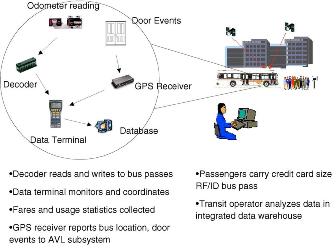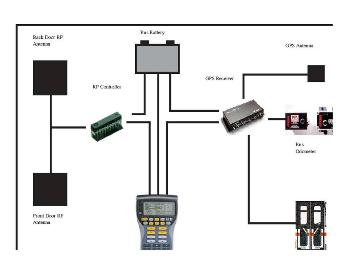|
Transit IDEA Project 10 addressed the need for improved methods of data collection concerning transit users and vehicles by developing a prototype radio frequency identification (RF/ID) tag that acts as a bus pass. Passengers carrying the cards can be uniquely identified and tracked throughout the transit system. This Phase II demonstration project, Transit IDEA Project 19, improved on the prototype by field testing an integrated automatic passenger counting (APC) system and automatic vehicle location (AVL) system based on GPS and RF/ID smart cards.
Project Results
During the Transit IDEA Project 10, a prototype based entirely on RF/ID tagging technology was developed and tested on a University of Virginia bus route using student volunteers. In addition to providing tags to bus passengers, RF/ID tags were embedded at bus stops along a route to track the movement of buses. Preliminary data were collected in near real-time. The read rate of the embedded tags was less than 50 percent. The data captured included passenger and bus stop identifiers and event times (arrival and departure times of buses and boarding/alighting times of transit users). From these data, information such as origin-destination pairs, passenger transit times, and schedule adherence were derived. The data were organized into a database and example summary reports were formulated. Passenger acceptance of smart cards and tracking was analyzed via surveys.

Figure 1
System concept diagram.
The results of the Transit IDEA 10 project indicated the potential of using radio frequency identification to integrate APC and AVL systems. The Transit 19 Phase II demonstration examined the integration of APC/AVL and other monitoring functions in the form of a Transit Integrated Monitoring System (TIMS). Objectives for Phase II included developing a demonstration system that (1) improved the hardware components of the Transit 10 prototypes, (2) enhanced the software architecture and software subsystems, and (3) enabled a better understanding of the operational performance of TIMS under transit conditions. A route within the Charlottesville Transit System served as the demonstration’s case study.
The hardware system was redesigned to utilize global positioning technology as the primary bus stop identification mechanism. In addition, the system concept was changed to allow fare collection on a portable data terminal mounted within the vehicle. The results include an object-oriented software architecture of the information content for the system, a set of use cases for the system, a design specification for the database, a design specification for the user interface, and the hardware requirements and specifications. The system was tested during a field trial of two weeks. The results of the testing yielded a 96.5 percent read reliability rate for the cards. In addition, if the cards are used as proximity devices, a 100 percent rate was achieved. The final product associated with this project is the completed design and specifications of TIMS using the software industry standard Unified Modeling Language, the integrated hardware and software, and a demonstrated system. The final report for the Transit IDEA project was completed.
Product Payoff Potential
The primary benefit of this project is the design of an integrated system that replaces the functionality of disjointed passenger counting, vehicle location, and fare collection systems at approximately the same cost. In addition, because the system can record boarding passengers’ fares automatically without the passenger having to remove the fare card from their purse or wallet, time can be saved.
For this demonstration, APC integration was achieved through the use of smart cards based on radio frequency technology; however, the hardware and software design specifications do not depend on the use of radio frequency based smart cards. The potential benefit of this project to practice depends on the acceptance of smart cards by the general population within the United States. Data from the Smart Card Forum suggests large gains in the smart card market within the next few years. Integrated systems such as TIMS can take advantage of the growing use of smart cards.

Figure 2
Hardware connections.
Product Transfer
The steps taken to facilitate product transfer include:
1. Partnerships with industry: The project was a joint effort between academic researchers and a smart card company Axcess Inc.
2. Partnerships with transit providers: Transit 10 was implemented on the University of Virginia transit system. Transit 19 was implemented on the Charlottesville Transit System.
3. Monitoring by a Transit Users Forum: The forum consisted of researchers and practitioners associated with the Virginia Department of Transportation, Charlottesville Transit System, and the Richmond Transit Authority.
4. Publications: Two journal articles, one conference paper, and one MS thesis.
Additional plans by the investigator as a follow-up to this project include:
¡ Seeking additional financing to enhance the system to include real-time DGPS, GIS, and Web-based interfaces.
NTIS # PB97-137533 and NTIS # PB99-113268.
The final report for this IDEA project can be found at:
https://onlinepubs.trb.org/onlinepubs/archive/studies/idea/finalreports/transit/Transit19_Final_Report.pdf.
|
|